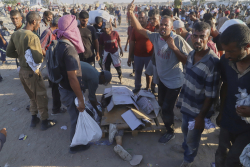Russia has increased production of its Su-34s—and has repeatedly touted the deliveries of additional aircraft to its Air Force.
Since the start of the ongoing “special military operation” in Ukraine, the Russian Aerospace Forces have lost as many as 38 of their Sukhoi Su-34 (NATO reporting name “Fullback”) fighter bombers. That would be more than one-fifth of its pre-war fleet, which was estimated to be around 140 aircraft. The losses are significantly impacting the Kremlin’s ability to carry out strike missions on adversarial targets.
Between two and four of the multirole warplanes were stated to be among the aircraft Ukraine destroyed in a glide bomb attack on the Russian Aerospace Force’s Manivka airbase in the Volgograd region in late June. That followed Kyiv’s Operation Spiderweb, the highly coordinated drone strikes on multiple Russian airbases that damaged or destroyed as many as 41 aircraft earlier in the month.
The Su-34 Fullback’s Specifications
- Year Introduced: 2014
- Number Built: Fewer than 200
- Length: 23.34 m (76 ft 7 in)
- Height: 6.09 m (20 ft 0 in)
- Wingspan: 14.7 m (48 ft 3 in)
- Weight:
- Empty – 22,500 kg (49,604 lb)
- Standard conditions – 39,000 kg (85,980 lb)
- Maximum takeoff weight – 45,100 kg (99,430 lb)
- Engines: 2 × Saturn AL-31FM1afterburning turbofan engines, 132 kN (30,000 lbf) with afterburner
- Top Speed: Mach 1.8 (1,900 km/h) at altitude, Mach 1.2 (1,400 km/h) at sea level
- Range: 4,000 km (2,485 mi) with external fuel tanks
- Service Ceiling: 14,650 m (48,000 ft)
- Loadout: One 30 mm GSh-301 cannon with 150 rounds, 12 hardpoints for a variety of air-to-air and air-to-surface missiles, guided bombs, and unguided rockets
- Aircrew: Two (2) side-by-side seating
More Su-34 Replacements Have Arrived
Russia has increased production and has repeatedly touted the deliveries of additional Su-34s.
“The United Aircraft Corporation has delivered new Su-34 fighter-bombers to the Defense Ministry of Russia. The aircraft have replenished the fleet of operational/tactical aviation of the Russian Aerospace Forces. The aircraft have been manufactured under the defense procurement plan for this year,” the United Aircraft Corporation (UAC), a subsidiary of the state-owned military-industrial conglomerate Rostec, announced this week, according to a report from Russia’s state-run TASS media agency.
TASS did not confirm how many fighter bombers were in this latest batch, but did report that the “aircraft have undergone a full cycle of factory trials and testing,” and could soon be deployed to units.
As previously reported by Maya Carlin for The National Interest, “Moscow has been able to sustain a higher production rate of this fighter-bomber platform and is expected to field roughly 300 Su-34s by the end of the decade.” However, those numbers are only accurate if the war does come to an end.
As it stands, it is unclear if Moscow’s aircraft production is keeping pace with the ongoing attrition. Even pulling back its combat aircraft to remote airbases has not succeeded in ensuring that they’re protected, as June’s Spiderweb highlighted.
The Su-34 Is a Great Warbird—but Too Few to Affect the War
The multirole twin-engine, twin-seat, all-weather supersonic medium-range fighter-bomber was initially developed for the Soviet Air Forces in the 1980s. Though based on the Sukhoi Su-27 (NATO reporting name “Flanker”) air superiority fighter, the Su-34 was developed to conduct solo and group bombing missions in all weather conditions. The aircraft was introduced to replace the aging Sukhoi Su-24 (NATO reporting name “Fencer”).
However, the Su-34 was one of the Kremlin’s many programs forced to the back burner following the dissolution of the Soviet Union and the economic crisis that followed.
The program was only revived in earnest in the early 2000s, with eight pre-production aircraft built for trials and evaluations. The Su-34 officially entered service in 2014, although there are reports that the strike aircraft was employed during the Russo-Georgia War of 2008.
“The Su-34 frontline bomber has long proved to be the best in its class,” stated Rostec Executive Director Oleg Yevtushenko. “The aircraft’s capabilities enable pilots to operate successfully in theaters of military operations and employ both unguided and guided air-launched weapons. The aircraft is needed in present-day combat operations, and our aircraft factories have ramped up production rates and ensure smooth deliveries to the troops.”
About the Author: Peter Suciu
Peter Suciu has contributed over 3,200 published pieces to more than four dozen magazines and websites over a 30-year career in journalism. He regularly writes about military hardware, firearms history, cybersecurity, politics, and international affairs. Peter is also a contributing writer for Forbes and Clearance Jobs. He is based in Michigan. You can follow him on Twitter: @PeterSuciu. You can email the author: [email protected].
Image: Wikimedia Commons.


















